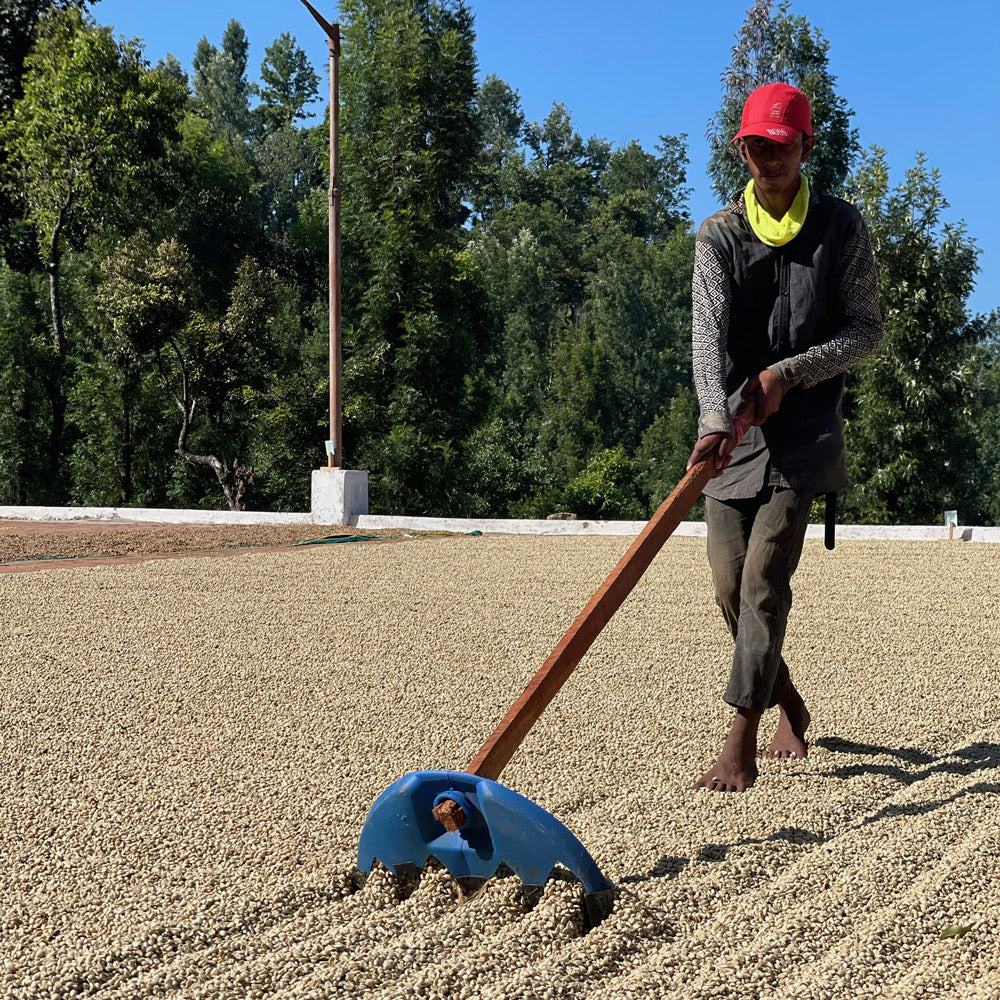
Hello, today we're talking about coffee cultivation and how this delicious brew actually comes to us. So, brew your favorite coffee and then we'll discover the world of coffee cultivation, coffee production and the origin of coffee. Dear coffee lovers - enjoy reading!
The production of coffee: From the bean to enjoyment
The journey of coffee begins far away from our cafés and kitchens. Coffee is not just any drink, but is one of the Germans' favorite beverages: on average, everyone drinks 168 liters per year. It's no wonder, then, that most people can't get through the day without their daily dose of caffeine. But where does coffee actually come from and what's behind it? Let's find out.
The Cradle of Humanity & Coffee: A Journey to Ethiopia
The country of origin of coffee is Ethiopia. According to legend, a goatherd noticed that his goats were jumping happily over hill and dale all night long after they had eaten the leaves of a certain bush. He imitated this by making the leaves into a tea and also observed the energizing effect. He was able to drive his herd until late in the evening. This story is the first tradition about coffee. However, it was still a long way before the beans ended up roasted and ground in our cups!

Where does coffee actually grow?
The coffee plant grows in the so-called coffee belt. This stretches across the equator: this is where the ideal growing conditions for coffee are found. Countries in the coffee belt are: Brazil, Vietnam, Colombia, Indonesia and of course Ethiopia - these are also the top 5 coffee growing countries. The constant climate, sufficient rainfall and optimal altitudes are ideal in these latitudes.
Arabica vs. Robusta
When it comes to growing coffee, two varieties are particularly interesting and dominate the market: Arabica and Robusta. The Robusta coffee plant is, as the name suggests, much more resilient than its sister. It grows from an altitude of 300m and does not need constant conditions. The Arabica coffee plant, on the other hand, is a real diva. It needs a certain cultivation altitude of 800m and temperatures between 20 - 25°C - otherwise it will die.
The terroir makes the difference
As with good wine, terroir plays a major role in coffee. It depends on the altitude, the type of soil and the amount of sunlight. All of these factors influence the taste and true experts can taste volcanic soil, cultivation by the sea and many other special features in the coffee.

From volcanoes to monsoons - the influence of nature
There's a reason why Hawaiian coffee, grown on volcanic soil, is one of the best in the world! Nature plays a really decisive role in the taste of our favorite drink. In India, in the Malabar region, for example, the coffee is exposed to the interplay of sun and monsoon rain, which gives it a unique taste!
Monoculture vs. mixed culture
There are various cultivation methods used to produce coffee - these in turn influence the taste. In monocultures, only coffee plants are grown in rows. This has the advantage of an easier harvest, often with mechanical help. This cultivation method is particularly common on very large farms. Mixed cultures, on the other hand, are often grown with other crops. Usually cocoa and fruit. These trees and bushes provide shade for the sensitive coffee plants and contribute to a species-rich environment, which significantly improves soil quality. You can also taste these mixed cultures - the coffee then has nuances of lemon, mango or chocolate, for example. However, the shade means that the coffee cherries take longer to ripen, which is why these farms are somewhat "less productive" than monocultures with full sunlight.
A beat with the calendar: the harvest time
The harvest time varies depending on the region and the growing area. In some, the coffee can be harvested up to twice a year. North of the equator, the harvest takes place mainly from September to April, and south of the equator, from April to August. We were just in India, where the harvest was almost over. If you are interested in our coffee trips, then follow us on Instagram !

From the plant to the cup
Growing coffee is the beginning of our coffee's exciting journey. After careful harvesting, the coffee cherries are separated from the 2 (!) coffee beans and dried using different processing methods. This can be done by machines or through natural fermentation processes in the sun. The dried coffee beans then come to our roastery, where they are roasted according to their individual needs . Each type of coffee needs its own treatment, as this is the only way to bring out the special aromas of the respective growing region. The coffee is then "aired" a little and packaged, before ending up on our shelves and then in your cups at home.
A look into the future: Sustainable coffee cultivation
Environmental protection is also becoming increasingly important in modern coffee cultivation. Unfortunately, cultivation no longer works without an intact environment and that is why we also have a responsibility. We and our farmers pay attention to environmentally friendly cultivation methods with natural shade, the avoidance of chemical fertilizers and pesticides and take social responsibility in the growing areas. All of this improves the quality of the coffee and protects the planet. And our coffees even get an organic seal for it.
Conclusion: Coffee cultivation is a world full of taste
Coffee is and remains diverse and fascinating. Every cup tells its own little story of distant countries, careful cultivation and the passion of the people who have made it their profession. If you want to find out more, we warmly invite you to our seminars . There is something for everyone from beginners to advanced - and of course fun is included.
Your Kaffeebrewda
